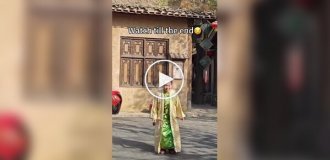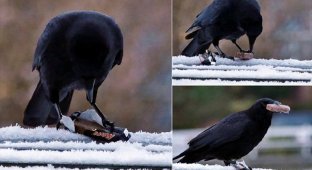Interesting facts about the hooded crow (13 photos + 2 videos)
Today I propose to get acquainted with the most synanthropic bird - the gray crow. Absolutely all residents of cities and villages know this bird.

A little biology
First, let's talk about taxonomy. As a separate species, the crow (Corvus cornix L.) was described by C. Linnaeus along with a closely related species, the black crow (Corvus corone L.). Further research revealed that in extensive contact zones, black and gray crows form mixed pairs and produce full-fledged offspring capable of reproduction. This indicates that hooded and black crows in nature have not yet achieved complete reproductive isolation, characteristic of real species. Therefore, taxonomists combined the black and hooded crows into one species - the crow (Corvus corone), giving them the rank of subspecies. Under a single species name, hooded and black crows were included in systematic reports and major monographs. However, a 2002 study showed that hybrids are not born in all cases and are inferior in health to purebred birds - a sign of the formation of a new species, its separation from the parent species. Now the scientific name of the hooded crow is Corvus cornix (actually just “crow”), and the black crow is Corvus corone.

The gray crow (lat. Corvus cornix) is a species of bird from the crow family. Externally, the hooded crow has a large black beak, their plumage on the head is black, the neck and part of the back are ash-gray, the wings are black, but in the sun they acquire reflections of green. Black tail and paws. The underbelly is also gray. The crow's tail is wedge-shaped, with long tail feathers. The bird's beak is powerful and sharp, conical in shape, and in some species has a characteristic high bend. The crow's legs are thin and long, with four toes: 1 facing back, 3 facing forward. And a rather graceful body structure. It moves along the ground with long strides and, in case of danger, begins to “jump.” An adult bird weighs from 400 to 700 grams, and its body length is about 50 centimeters, with a wingspan of up to 1 meter. Distributed in Eurasia, where it reaches the Yenisei. A sedentary-nomadic species, it completely disappears in winter only from the northern periphery of its range.
Crows are omnivorous birds, they feed on insects, chicks and eggs, rodents and lizards, frogs, fish; plant food - seeds of various plants, as well as the plants themselves, as well as food waste and carrion, which is of great importance for sanitation.

The hooded crow begins nesting in March-April (depending on the climate). When crows build nests, they separate from the flock and try to guard the boundaries of their territory. In cities, a widespread breakdown into pairs and mating games can be observed as early as February. The earliest chicks appear no earlier than April, in one clutch there are 3-6 eggs, less often up to 7-8. Birds, as a rule, do not use old nests; they make new ones, but not far from the old ones. In the wild, birds breed at a distance of 1-2 km from another pair; in the city this gap is significantly smaller. The breeding season is preceded by aerial games, chases, and somersaults in the air. The partners build a new nest every season. The hooded crow begins nesting in March-April (depending on the climate). Birds make nests in parks and squares, in the forks of thick tree branches, power line supports, cranes, and behind drainpipes. Crows build nests from dry branches or reeds, fastened with clay and turf; in addition, they often use wire and line the nest with feathers, grass, tow, cotton wool, rags, and synthetics. Near the nest it behaves cautiously and unnoticed. As is known, the limits of clutch volume in birds are a genetically determined feature. In crows, the minimum volume of a complete clutch is 2 eggs, the maximum is 6, and on average clutches contain from 3 to 5 eggs. The female lays 4-6 bluish-green eggs with dark specks from late March to May.


They are incubated by one female for 18-19 days, without leaving the nest around the clock, the male feeds her during the incubation period. After 25 days, the chicks hatch and are fed by both parents. Growing chicks need food that is easily digestible and has enough calories. The best food for them is the eggs of other birds. Crows mercilessly rob other people's nests to feed their chicks. The chicks fly out around mid-June and stay with their parents, who feed them, for some time. In July, family flocks break up.

By autumn, crows concentrate in large numbers around landfills, garbage dumps and other food sources. They reproduce in the 2-5th year of life. The maximum age known with certainty is 20 years.

Interesting facts about crows
- The crow is a professional scavenger with concentrated acid in the stomach, high body temperature and resistance to a huge number of infections. It is from her that a person has practically no chance of catching an infection. Moreover, by destroying dead birds of other species, as well as the carcasses of mice and rats, crows prevent the spread of many infections.
- In Moscow, at the Rizhsky station, half a century ago, biologists noticed that crows had perfectly learned the schedule of country trains and learned to fly up to the platform just when the train was approaching the platform. The birds quickly flew into all vestibules one by one, looking for scraps abandoned by passengers on the previous flight. Moreover, the sparrows and pigeons living there have learned crow habits, and to this day bird patrols regularly fly over electric trains.
- Crows hide their prey, making sure that no one sees it. If another bird suddenly witnesses such an action, the prey will be hidden, but only when the unexpected witness disappears.

- Female crows are quite picky in choosing a partner and look for certain qualities or traits in them. A good chosen one should be able to provide for his “family” and be smart enough. Males do everything to attract female attention: loops, flying belly up, and other aerobatics.
- Crows communicate with each other, the raven language is extremely developed, has a rich “vocabulary”. It has special sounds for courting a female, calling on young animals, gathering, swearing, threats, alarms, and distress. Sometimes several birds make one sound, in unison. For more volume. In cases where a general fee is announced. The sounds made by crows fall within the range from 0.5 to 4.0 kHz. And here’s what’s remarkable: in different countries these birds have their own dialects - they do not immediately understand each other.

- Crows leave most of their droppings under their nests, which they build in trees (that’s where you definitely shouldn’t park your car). The crow, the only bird, can be trained to use the toilet - precisely because the bird knows how to control this process, tries not to get dirty in its nest and usually empties its intestines when flying out and entering it.
- Crows create one pair for life. If a predator approaches, males may sacrifice themselves to save their mate and chicks.
- There is another strange thing in the behavior of birds: when a crow dies, its comrades arrange a memorial service. Having discovered the body of a dead bird, they fill the space with heartbreaking cries for fifteen minutes, as if on command the birds wipe out, sit on the branches and remain mournfully silent. Modern researchers cannot explain this phenomenon.
- Crows can count. If a crow is offered a choice of two feeders containing different amounts of food, it will almost always choose the one with more food. For example, 14 beetles were placed in one feeder, and 15 in another. A person could not immediately determine where there were more beetles, but the crows did it with ease. In addition, crows very quickly learn to recognize numbers and can later even determine which number is larger and which is smaller!

- Crows don’t just remember their offender, they pass information on to other birds. The surprising thing is that even “children” will be hostile against those who were “scold” by their parents.
- City crows love games, they are not afraid of dogs and cats. In the forest, birds often play with predators; people have observed birds chasing a fox, a wolf or an otter. In winter, people often watched birds sliding from the ice mountain and church domes. Crows also love team games. One of the birds holds some small object in its beak, it could be a stick, a cone or a stone. The crow takes off confidently and passes the “pass” to the other player. This continues until the toy is on the ground.
- So, crows correctly determine the meaning of traffic lights - when the light is red, they calmly pick up the corpses of animals hit by cars on the road, and when the light is green, they fly away. They can perfectly distinguish what is in a person's hands - a stick or a gun; they can distinguish between a child and an adult, a man and a woman. But it seems that this is not the limit and crows are capable of more. They may do something unusual. Stop, look around, assess the situation. Remember what you saw before.
- In cold weather, they sit down at night and huddle closely together, tucking their heads under their wings and fluffing up their feathers, which retain heat well.
- Hooded crows not only talk, but also master the very language in which they are communicated. If a crow begins to imitate a voice, it does so with such intonations that you cannot distinguish the voice of a person you know from the voice of a crow.

- The crow, unlike other birds, eats the contents of a stolen egg far from the crime scene and unseals it from the blunt end. To transport stolen goods, the bird punches a hole in the egg and inserts the upper part of its beak into the resulting hole, holding the prey from below. And so, with her mouth open, she leaves the crime scene.
- In addition, crows have excellent memory and high learning ability. According to experts, they have the ability for rational activity, exhibit associative and logical thinking, and have basic mathematical knowledge (count to five, distinguish shape, symmetry, size ratio, three-dimensional bodies and flat figures).
- If in any place the nesting population of crows grows too much, the birds themselves reduce the number of offspring. Large overpopulation influences the growth of aggressiveness of crows, and they mercilessly destroy the nests of their relatives.
- When a bird finds dry bread, it will not immediately eat rough food. The bird will look for a source, suitable for any puddle, and wait until the crust softens.
- The crow dropped a crust of dried bread into the stream, and it disappeared into the pipe, carried away by the fast current. At first, the bird settled at the entrance to the pipe and peered into the darkness for a long time. Then she confidently headed to the opposite end of the pipe, where she waited for the lost prey. That is, the crow was able to correctly predict the course of events and showed the ability to extrapolate.
- There have been cases when a crow, protecting its offspring, threw small stones at people approaching the nest.
- Communication means. The sound signaling of birds is especially diverse. If chickens make 13 different sounds, roosters 15, tits 90, then rooks - 120, and hooded crows - up to 300 (!). Most researchers are convinced of the signaling nature of these sounds. With their help, birds convey their general emotional and mental state - anxiety, aggressiveness, joy from communication or pleasure in finding food. However, some ornithologists believe that birds have their own language, which is a means of communication to convey certain information.
- The hooded crow is one of the most synanthropic representatives of corvids, a typical inhabitant of cities. There are both completely sedentary urban populations, and populations nesting in natural landscapes, as well as transitional ones. Many individuals living in forests and rural areas spend the winter in the suburbs and cities.
- When feeding on a relatively compact food source (tank with food waste, a large piece of difficult-to-divide food, etc.), feeding of group members occurs in a relatively strict sequence. Filming data from feeding groups allows us to distinguish three hierarchical levels (strata). Priority is always with the local adult couple. From the food they can displace and expel any other member of the group. Conflicts rarely arise between members of a couple. When feeding one of them, the second one waits nearby, maintaining an individual distance and a certain orientation in relation to the partner. In the absence of hosts, priority in feeding goes to some individuals of the second hierarchical level. This usually includes all birds of local origin (including first-year birds) included in the group, as well as some immigrants. Within this hierarchical stratum there is a hierarchy of a linear type, but not as rigid and stable over time as between strata. The third hierarchical level, as a rule, consists of birds from mobile groups, temporarily feeding as part of a sedentary group.
- Watching these birds, you can notice: if a person just walks along the street, the crows do not seem to notice him and can let him get within 2-3 meters. But as soon as he stops and looks closely at them, they immediately jump back about 10 meters.

- There is a famous fable by Aesop about how a crow threw stones into a jug to get to the water. Scientists decided to reproduce the events of the fable. Moreover, they did this with different crows four times and got the same results. A crow, a deep container of water with tasty worms floating in it, and a pile of pebbles were placed in the cage. The crows couldn't just get the worms. The results are amazing - 2 crows managed to find a solution on the second try, the rest figured it out the first time. At the same time, they began to throw not just any stones, but chose the largest ones. And they threw it exactly until the moment it became possible to pull the worms out of the rising water.
- In the 1950-1960s, Moscow University professor Leonid Viktorovich Krushinsky conducted interesting research into the abilities of animals. He proved that different animals act intelligently in a new environment, and not simply on the basis of unconditioned and conditioned reflexes.
- Crows like a very strange activity called enting. It involves crushing ants and rubbing them into the body. When ants are crushed, formic acid is released, which is absorbed into the crows' skin and apparently gives them a very pleasant sensation. Why are they doing that? No one knows for sure, but there is no shortage of hypotheses. One such hypothesis is that enting is a form of ant cooking that makes crows immune to formic acid. This allows the crows to eat the ants without adverse consequences.
Others believe that enting is a learned behavior or instinct that birds cannot do anything about. Perhaps formic acid is used as a kind of bath oil and has a soothing effect on the skin of birds. At the same time, the enting birds seem to be in a state of complete bliss. Maybe in reality everything is much simpler. And perhaps crows and other birds cover themselves in squashed ants simply because they enjoy it.
- Crows are able to ride on snowy hills solely for the purpose of entertainment. It is not uncommon to see crows playing with other animals, most often cats and dogs. And in the wild there are otters and wolves. In the game, the crow can use sticks, cones, balls and other objects that it finds nearby.

Who's too lazy to read






















